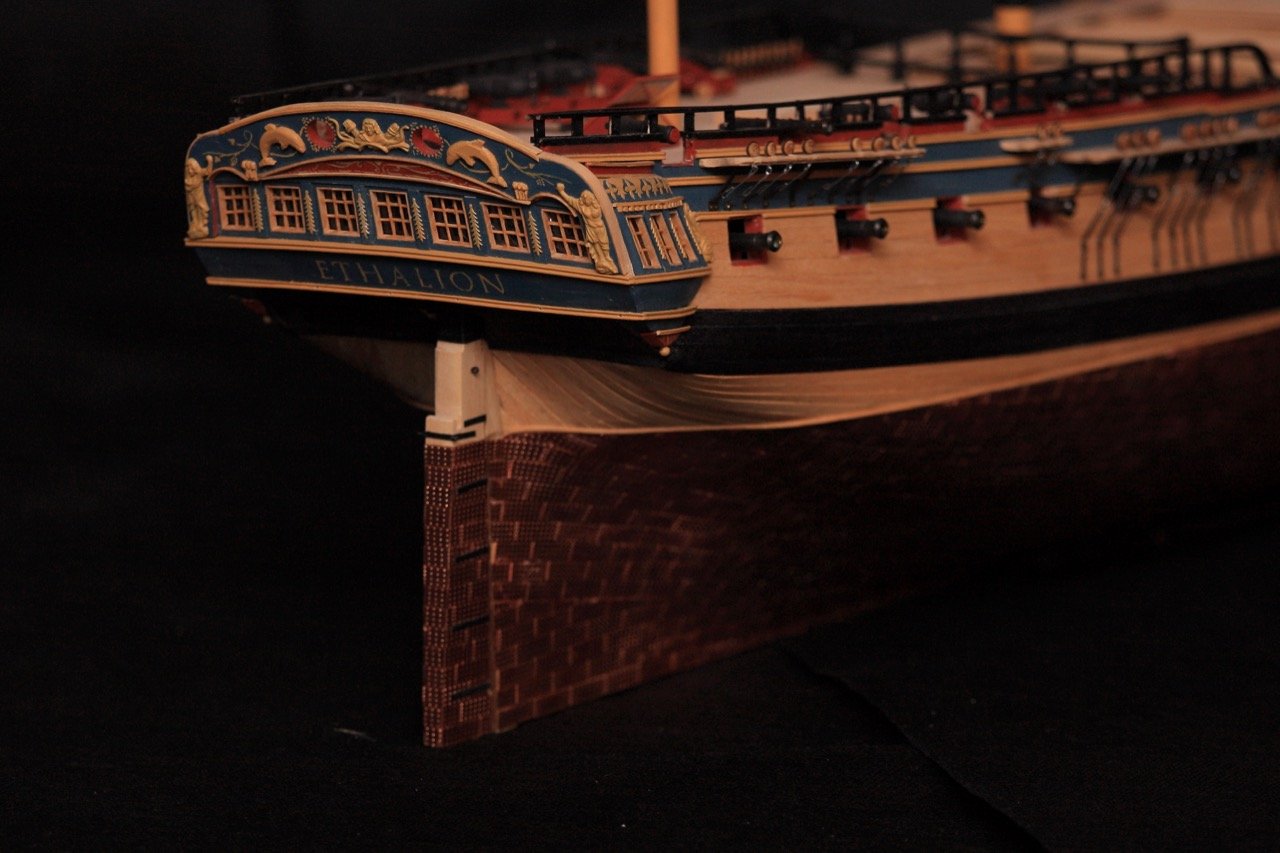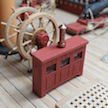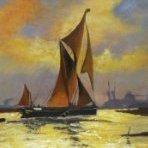-
Posts
830 -
Joined
-
Last visited
Reputation Activity
-
 robdurant reacted to Panteg Models in St. Roch by Panteg Models - Billing Boats 605 - 1:72 - RCMP Arctic Patrol Boat
robdurant reacted to Panteg Models in St. Roch by Panteg Models - Billing Boats 605 - 1:72 - RCMP Arctic Patrol Boat
This weeks progress so far on the St Roch.
-
 robdurant got a reaction from dunnock in Erycina by robdurant - FINISHED - Vanguard Models - 1:64 - Plymouth Ketch-Rigged Trawler
robdurant got a reaction from dunnock in Erycina by robdurant - FINISHED - Vanguard Models - 1:64 - Plymouth Ketch-Rigged Trawler
And... onto the masts. I haven't cut down the top of the mast yet, but couldn't resist seeing how it looked in situ.
-
 robdurant got a reaction from gak1965 in Erycina by robdurant - FINISHED - Vanguard Models - 1:64 - Plymouth Ketch-Rigged Trawler
robdurant got a reaction from gak1965 in Erycina by robdurant - FINISHED - Vanguard Models - 1:64 - Plymouth Ketch-Rigged Trawler
It's been a productive week. So here's an update. I've finished off all the deck furniture, and added the belaying pins (blackened photo-etch), and the chain plates...
The chain plates were marked out from the plans using masking tape to protect the hull as I put pencil marks on to show where they should go. Once I was happy with the arrangement, I drilled a hole in each to locate the first pin, and then removed the masking tape. The remaining holes were drilled, and the provided pins were fixed in, having first blackened the heads. (It's worth noting that on the top holes of the forward and rear chainplates, the hole shouldn't end up sticking out on the far side of the bulwark. To avoid this, I shortened the pin before gluing it in place with a small dab of superglue.
I've also dyed the sail set (these are the premium sails sold separately by Chris at Vanguard, and they really do add to the model). I used Rit dyes for this. About two pints of water were boiled in a big stainless steel pan, then having given it a few minutes to start cooling, I added two teaspoons of Rit Wine powder and Rit Dark Brown powder, half a teaspoon of salt, and a tiny dribble of washing up liquid. Having thoroughly stirred the mixture, the sails were added, ensuring they were completely submerged and wet through. About 30 seconds later, I took out the sails, and lay them out to remove the worst of the liquid. They were then placed on a cooling rack to dry off, turning occasionally.
I was really pleased with how these turned out. When I build Lady Isabella (the Zulu from Vanguard's range), I felt the sails ended up a little light... this time, I've managed to get a deeper, richer colour.
I'm almost onto the masts now, so soon I'll get the chance to see how they look on Erycina!
Thanks for all the likes and encouragement
Rob
-
 robdurant got a reaction from rcweir in Erycina by robdurant - FINISHED - Vanguard Models - 1:64 - Plymouth Ketch-Rigged Trawler
robdurant got a reaction from rcweir in Erycina by robdurant - FINISHED - Vanguard Models - 1:64 - Plymouth Ketch-Rigged Trawler
And... onto the masts. I haven't cut down the top of the mast yet, but couldn't resist seeing how it looked in situ.
-
 robdurant got a reaction from AJohnson in Erycina by robdurant - FINISHED - Vanguard Models - 1:64 - Plymouth Ketch-Rigged Trawler
robdurant got a reaction from AJohnson in Erycina by robdurant - FINISHED - Vanguard Models - 1:64 - Plymouth Ketch-Rigged Trawler
And... onto the masts. I haven't cut down the top of the mast yet, but couldn't resist seeing how it looked in situ.
-
 robdurant got a reaction from Craigie65 in Erycina by robdurant - FINISHED - Vanguard Models - 1:64 - Plymouth Ketch-Rigged Trawler
robdurant got a reaction from Craigie65 in Erycina by robdurant - FINISHED - Vanguard Models - 1:64 - Plymouth Ketch-Rigged Trawler
And... onto the masts. I haven't cut down the top of the mast yet, but couldn't resist seeing how it looked in situ.
-
 robdurant got a reaction from chris watton in Erycina by robdurant - FINISHED - Vanguard Models - 1:64 - Plymouth Ketch-Rigged Trawler
robdurant got a reaction from chris watton in Erycina by robdurant - FINISHED - Vanguard Models - 1:64 - Plymouth Ketch-Rigged Trawler
And... onto the masts. I haven't cut down the top of the mast yet, but couldn't resist seeing how it looked in situ.
-
 robdurant got a reaction from JacquesCousteau in Erycina by robdurant - FINISHED - Vanguard Models - 1:64 - Plymouth Ketch-Rigged Trawler
robdurant got a reaction from JacquesCousteau in Erycina by robdurant - FINISHED - Vanguard Models - 1:64 - Plymouth Ketch-Rigged Trawler
And... onto the masts. I haven't cut down the top of the mast yet, but couldn't resist seeing how it looked in situ.
-
 robdurant got a reaction from dunnock in Erycina by robdurant - FINISHED - Vanguard Models - 1:64 - Plymouth Ketch-Rigged Trawler
robdurant got a reaction from dunnock in Erycina by robdurant - FINISHED - Vanguard Models - 1:64 - Plymouth Ketch-Rigged Trawler
It's been a productive week. So here's an update. I've finished off all the deck furniture, and added the belaying pins (blackened photo-etch), and the chain plates...
The chain plates were marked out from the plans using masking tape to protect the hull as I put pencil marks on to show where they should go. Once I was happy with the arrangement, I drilled a hole in each to locate the first pin, and then removed the masking tape. The remaining holes were drilled, and the provided pins were fixed in, having first blackened the heads. (It's worth noting that on the top holes of the forward and rear chainplates, the hole shouldn't end up sticking out on the far side of the bulwark. To avoid this, I shortened the pin before gluing it in place with a small dab of superglue.
I've also dyed the sail set (these are the premium sails sold separately by Chris at Vanguard, and they really do add to the model). I used Rit dyes for this. About two pints of water were boiled in a big stainless steel pan, then having given it a few minutes to start cooling, I added two teaspoons of Rit Wine powder and Rit Dark Brown powder, half a teaspoon of salt, and a tiny dribble of washing up liquid. Having thoroughly stirred the mixture, the sails were added, ensuring they were completely submerged and wet through. About 30 seconds later, I took out the sails, and lay them out to remove the worst of the liquid. They were then placed on a cooling rack to dry off, turning occasionally.
I was really pleased with how these turned out. When I build Lady Isabella (the Zulu from Vanguard's range), I felt the sails ended up a little light... this time, I've managed to get a deeper, richer colour.
I'm almost onto the masts now, so soon I'll get the chance to see how they look on Erycina!
Thanks for all the likes and encouragement
Rob
-
 robdurant got a reaction from rcweir in Erycina by robdurant - FINISHED - Vanguard Models - 1:64 - Plymouth Ketch-Rigged Trawler
robdurant got a reaction from rcweir in Erycina by robdurant - FINISHED - Vanguard Models - 1:64 - Plymouth Ketch-Rigged Trawler
It's been a productive week. So here's an update. I've finished off all the deck furniture, and added the belaying pins (blackened photo-etch), and the chain plates...
The chain plates were marked out from the plans using masking tape to protect the hull as I put pencil marks on to show where they should go. Once I was happy with the arrangement, I drilled a hole in each to locate the first pin, and then removed the masking tape. The remaining holes were drilled, and the provided pins were fixed in, having first blackened the heads. (It's worth noting that on the top holes of the forward and rear chainplates, the hole shouldn't end up sticking out on the far side of the bulwark. To avoid this, I shortened the pin before gluing it in place with a small dab of superglue.
I've also dyed the sail set (these are the premium sails sold separately by Chris at Vanguard, and they really do add to the model). I used Rit dyes for this. About two pints of water were boiled in a big stainless steel pan, then having given it a few minutes to start cooling, I added two teaspoons of Rit Wine powder and Rit Dark Brown powder, half a teaspoon of salt, and a tiny dribble of washing up liquid. Having thoroughly stirred the mixture, the sails were added, ensuring they were completely submerged and wet through. About 30 seconds later, I took out the sails, and lay them out to remove the worst of the liquid. They were then placed on a cooling rack to dry off, turning occasionally.
I was really pleased with how these turned out. When I build Lady Isabella (the Zulu from Vanguard's range), I felt the sails ended up a little light... this time, I've managed to get a deeper, richer colour.
I'm almost onto the masts now, so soon I'll get the chance to see how they look on Erycina!
Thanks for all the likes and encouragement
Rob
-
 robdurant got a reaction from chris watton in Erycina by robdurant - FINISHED - Vanguard Models - 1:64 - Plymouth Ketch-Rigged Trawler
robdurant got a reaction from chris watton in Erycina by robdurant - FINISHED - Vanguard Models - 1:64 - Plymouth Ketch-Rigged Trawler
It's been a productive week. So here's an update. I've finished off all the deck furniture, and added the belaying pins (blackened photo-etch), and the chain plates...
The chain plates were marked out from the plans using masking tape to protect the hull as I put pencil marks on to show where they should go. Once I was happy with the arrangement, I drilled a hole in each to locate the first pin, and then removed the masking tape. The remaining holes were drilled, and the provided pins were fixed in, having first blackened the heads. (It's worth noting that on the top holes of the forward and rear chainplates, the hole shouldn't end up sticking out on the far side of the bulwark. To avoid this, I shortened the pin before gluing it in place with a small dab of superglue.
I've also dyed the sail set (these are the premium sails sold separately by Chris at Vanguard, and they really do add to the model). I used Rit dyes for this. About two pints of water were boiled in a big stainless steel pan, then having given it a few minutes to start cooling, I added two teaspoons of Rit Wine powder and Rit Dark Brown powder, half a teaspoon of salt, and a tiny dribble of washing up liquid. Having thoroughly stirred the mixture, the sails were added, ensuring they were completely submerged and wet through. About 30 seconds later, I took out the sails, and lay them out to remove the worst of the liquid. They were then placed on a cooling rack to dry off, turning occasionally.
I was really pleased with how these turned out. When I build Lady Isabella (the Zulu from Vanguard's range), I felt the sails ended up a little light... this time, I've managed to get a deeper, richer colour.
I'm almost onto the masts now, so soon I'll get the chance to see how they look on Erycina!
Thanks for all the likes and encouragement
Rob
-
 robdurant got a reaction from ccoyle in Erycina by robdurant - FINISHED - Vanguard Models - 1:64 - Plymouth Ketch-Rigged Trawler
robdurant got a reaction from ccoyle in Erycina by robdurant - FINISHED - Vanguard Models - 1:64 - Plymouth Ketch-Rigged Trawler
It's been a productive week. So here's an update. I've finished off all the deck furniture, and added the belaying pins (blackened photo-etch), and the chain plates...
The chain plates were marked out from the plans using masking tape to protect the hull as I put pencil marks on to show where they should go. Once I was happy with the arrangement, I drilled a hole in each to locate the first pin, and then removed the masking tape. The remaining holes were drilled, and the provided pins were fixed in, having first blackened the heads. (It's worth noting that on the top holes of the forward and rear chainplates, the hole shouldn't end up sticking out on the far side of the bulwark. To avoid this, I shortened the pin before gluing it in place with a small dab of superglue.
I've also dyed the sail set (these are the premium sails sold separately by Chris at Vanguard, and they really do add to the model). I used Rit dyes for this. About two pints of water were boiled in a big stainless steel pan, then having given it a few minutes to start cooling, I added two teaspoons of Rit Wine powder and Rit Dark Brown powder, half a teaspoon of salt, and a tiny dribble of washing up liquid. Having thoroughly stirred the mixture, the sails were added, ensuring they were completely submerged and wet through. About 30 seconds later, I took out the sails, and lay them out to remove the worst of the liquid. They were then placed on a cooling rack to dry off, turning occasionally.
I was really pleased with how these turned out. When I build Lady Isabella (the Zulu from Vanguard's range), I felt the sails ended up a little light... this time, I've managed to get a deeper, richer colour.
I'm almost onto the masts now, so soon I'll get the chance to see how they look on Erycina!
Thanks for all the likes and encouragement
Rob
-
 robdurant got a reaction from AJohnson in Erycina by robdurant - FINISHED - Vanguard Models - 1:64 - Plymouth Ketch-Rigged Trawler
robdurant got a reaction from AJohnson in Erycina by robdurant - FINISHED - Vanguard Models - 1:64 - Plymouth Ketch-Rigged Trawler
It's been a productive week. So here's an update. I've finished off all the deck furniture, and added the belaying pins (blackened photo-etch), and the chain plates...
The chain plates were marked out from the plans using masking tape to protect the hull as I put pencil marks on to show where they should go. Once I was happy with the arrangement, I drilled a hole in each to locate the first pin, and then removed the masking tape. The remaining holes were drilled, and the provided pins were fixed in, having first blackened the heads. (It's worth noting that on the top holes of the forward and rear chainplates, the hole shouldn't end up sticking out on the far side of the bulwark. To avoid this, I shortened the pin before gluing it in place with a small dab of superglue.
I've also dyed the sail set (these are the premium sails sold separately by Chris at Vanguard, and they really do add to the model). I used Rit dyes for this. About two pints of water were boiled in a big stainless steel pan, then having given it a few minutes to start cooling, I added two teaspoons of Rit Wine powder and Rit Dark Brown powder, half a teaspoon of salt, and a tiny dribble of washing up liquid. Having thoroughly stirred the mixture, the sails were added, ensuring they were completely submerged and wet through. About 30 seconds later, I took out the sails, and lay them out to remove the worst of the liquid. They were then placed on a cooling rack to dry off, turning occasionally.
I was really pleased with how these turned out. When I build Lady Isabella (the Zulu from Vanguard's range), I felt the sails ended up a little light... this time, I've managed to get a deeper, richer colour.
I'm almost onto the masts now, so soon I'll get the chance to see how they look on Erycina!
Thanks for all the likes and encouragement
Rob
-
 robdurant got a reaction from gak1965 in Erycina by robdurant - FINISHED - Vanguard Models - 1:64 - Plymouth Ketch-Rigged Trawler
robdurant got a reaction from gak1965 in Erycina by robdurant - FINISHED - Vanguard Models - 1:64 - Plymouth Ketch-Rigged Trawler
Hi,
A little bit more progress. I've added the details to the companionway, and installed it in place. I've also constructed the main sheet housing assembly and the eyelets in the deck. I replaced the photo-etch for these with wire versions (which I had left over from previous builds), as they're more rounded, and I think I prefer the look overall. Whether you'd really ever notice the difference is another matter entirely, but I'll know
A (very-zoomed-in) comparison of the wire and the photo-etch eyelets:
And installed... I haven't currently glued the eyebolt holding the double-block in place as I wasn't sure how easy it would be to rig, and I wanted to keep the option open to get more access if I wanted it.
It amazes me how much slower building is these days. When I built Lady Isabella, I was working six-day weeks and it took me four months. But progress is progress, and I'm enjoying building this model immensely!
Thanks for looking in
Rob
-
 robdurant reacted to FlyingFish in Vigilance of Brixham (BM 76) by FlyingFish - 1:32
robdurant reacted to FlyingFish in Vigilance of Brixham (BM 76) by FlyingFish - 1:32
Update
Thanks for the views, comments and 'thumbs up'!
Well time in the shop has been limited recently; a prolonged spell of dry settled weather has allowed me to get on with several jobs outside that needed doing – a pair of new shed doors, clearing out downpipes and fixing gutters etc. Not to mention a few bonus fishing trips. All unexpected but very welcome.
A change to colder weather brings me back on task.
During this time, Vigilance No. 1 took on a mild twist. That’s what comes of leaving a framed boat un-planked for too long, despite leaving her well held in the building jig.. It wasn’t much but would have thrown things out of kilter later on, so took the time to fix it.
It necessitated taking off the shelves and clamps, stringers and the haunch timbers, hitching her back into shape and re-gluing. A pain but it’s done.
I will say that C/A glue is actually a whole lot easier to unstick than PVA – a quick wipe with acetone on a brush. Leave a few minutes than pry carefully apart.
Anyway, onto the next step.
A preamble to planking. [Skip this section if you want to avoid my inane ramblings – I’m simply planning aloud].
I had naively assumed that I could plank both versions simultaneously. A moment’s thought shows that version 1 (cutaway); ‘plank on frame’ and version 2 (fully built); ‘plank on station or bulkhead’ requires different approaches, even if the intention is that the resulting hulls will look the same.
Even if the planks are identical, the positions of the frames (V1) and stations (V2) are different, and hence the ‘tick strips’ or whatever needs to be original to each version.
Additionally, version 1 has frames at 6° to the heel, whereas version 2 has stations perpendicular to the keel.
I think it will become confusing to try and log these together, so let’s concentrate on what’s common to both for the moment.
The method described is that used originally, and by the shipyard, so far as I can see.
Once the frames are roughly faired, battens are placed at sheer and at intervals down the stem to the rabbet line on the keel, as shown, all adjusted to create fair lines.
These create bands of planking to be filled in stages, starting with the garboard & sheer. The distance between the battens is divided to give the planking width in each band, although in practice, planks are put on at each ribband position first, then the gaps filled with shutter planks spiled as necessary.
The position of the battens is decided when designing the line-off plan, and by consideration of what they do to the plank width. Convention is that a plank should not reduce by more than half it’s width, and that where possible stealers etc should be avoided. This whole subject is vast, and open to all sorts of interpretation. I don’t pretend to know very much about it, but the principles are straightforward enough – ‘do what looks good and works with the wood’. In other words, keep it fair and avoid too much edge setting. There are many excellent tutorials around, including several on this forum to which I can add nothing.
The simplest method is to measure the length of each station’s girth from sheer to keel and divide it by the number of planks required. This gives the width of each plank at each station. However, for some hull shapes (including Vigilance) this may not work when the lines are pinched or stretched at either end of the boat, and the widths are either too narrow or too broad, necessitating stealers, broadstrakes or suchlike.
For such boats one method involves drawing one or more lines along the hull, made by stretching a string along its length so that it proscribes the shortest path from stem the stern. A dead straight plank lays perfectly on this 'Magic' line and will need no edge setting, because it is a right-angles to the hull at every point. This becomes the ribband that defines the point above which planks are identical in shape (other than the bevel). By which I mean they will have the same width at each station. Below this line the planking requires a different approach due to the more acute shapes below the waterline. (Credit due to Mr Sauzedde for the explanation).
So back to practicalities and how to line off Vigilance, starting with what we know about her.
The photograph of Vigilance at Newlyn shows her with 21 planks not easily discerned, edged yellow below. Planks 10,11,&12 at the turn of the bilge were thicker, as were the three topside strakes. Strakes 1 – 7 were wider over the deadwoods at the sternpost to allow the narrower planks to fall more fairly under the counter.
Over the years and several re-plankings later, she still had 21 planks when she arrived at the yard in August 2023.
Planks10 11 and 12 were thicker, as were the top three strakes. Planks 8 and 9 reduced into one plank at around frame 5 or 6 on both sides at some time – unsure if this is original, but to be avoided in the plan.
Planking was 2 3/8” thick ; planks 10, 11 and 12 at the turn of the bilge are thicker at 3”, as are the three topsides.
The garboard is 7” wide at the midpoint frame 18, and the sheer and the four topsides below it are also wider than the bilge band at the midline by about an inch.
As mentioned, the planking widens over the aft deadwood section, another shot of this below.
As the planks come under the counter at the stern they first terminate onto the sternpost, then as they go above the sternpost onto the stern tube each butts the opposing plank at the centreline, as shown in the image. Plank 8 marks the intersection of the stern post and the counter, and is a good place to consider marking a fair line above which the planking is all of similar widths at each section, as previously described.
The battens below show how the planking bands work under the counter, and how the planks butt above the stern post.
To create a fair line from the bilge to the intersection of the sternpost and stern tube it is necessary to widen the first 6 planks above the garboard from the keel as they run over the deadwood and up the concave surface of the frames.
This can be seen in the final image below, the bottom edge of plank 7 marked.
So the idea is to mark the position of the batten at the sheer and the next ribband on the line just described joining the 7/8 planks junction at the point where the stern post enters the counter planking at the stern tube. It’s a bit arbitrary; one could equally have used the planks 8/9 boundary (as I think the yard did), but keeping the seven lower planks together works well I think.
The last decision is where to terminate this line at the stem.
The planking has equal widths from the garboard to the sheer at the stem, so this really takes care of the last position we need to map out the first band of planking.
Using the sectional plans of the frames at key points the position of the top of plank 7 (as determined by division of the frame length) can be mapped onto the boat in CAD. Putting all this information together we can plot the batten line we need as shown (line with dots along it). Below these the lower 7 planks are faired.
Interestingly when checked on the model this line does correspond nicely to the ‘magic’ line where a plank sits straight without edge setting.
I found a picture of plank 8 being fitted and you can see it needs no bevel and little or no edge setting. Lou would be pleased.
Above this line planking is divided equally into further bands using battens.
From the CAD plans it’s possible to measure the distance up each frame that the planks cross, at least at key points like the top of plank 7 and the other batten lines. The ability to accurately measure the length of a curve on a plan is an unexpected bonus of using CAD.
These can be transferred onto the model with a bit of care, and planking can progress from the garboard to the ‘magic line’ then downwards from the sheer. I may well have another band somewhere in the bilge area, but I want to avoid having to spire in more than necessary.
So that’s my happy task ahead.
If you’ve followed all this so far you deserve a medal. Or like me, a nice little glass of calvados, a momento of a recent trip to Brittany.
All for now!
Widen planks in this area
-
 robdurant got a reaction from dunnock in Erycina by robdurant - FINISHED - Vanguard Models - 1:64 - Plymouth Ketch-Rigged Trawler
robdurant got a reaction from dunnock in Erycina by robdurant - FINISHED - Vanguard Models - 1:64 - Plymouth Ketch-Rigged Trawler
Hi,
A little bit more progress. I've added the details to the companionway, and installed it in place. I've also constructed the main sheet housing assembly and the eyelets in the deck. I replaced the photo-etch for these with wire versions (which I had left over from previous builds), as they're more rounded, and I think I prefer the look overall. Whether you'd really ever notice the difference is another matter entirely, but I'll know
A (very-zoomed-in) comparison of the wire and the photo-etch eyelets:
And installed... I haven't currently glued the eyebolt holding the double-block in place as I wasn't sure how easy it would be to rig, and I wanted to keep the option open to get more access if I wanted it.
It amazes me how much slower building is these days. When I built Lady Isabella, I was working six-day weeks and it took me four months. But progress is progress, and I'm enjoying building this model immensely!
Thanks for looking in
Rob
-
 robdurant got a reaction from rcweir in Erycina by robdurant - FINISHED - Vanguard Models - 1:64 - Plymouth Ketch-Rigged Trawler
robdurant got a reaction from rcweir in Erycina by robdurant - FINISHED - Vanguard Models - 1:64 - Plymouth Ketch-Rigged Trawler
Hi,
A little bit more progress. I've added the details to the companionway, and installed it in place. I've also constructed the main sheet housing assembly and the eyelets in the deck. I replaced the photo-etch for these with wire versions (which I had left over from previous builds), as they're more rounded, and I think I prefer the look overall. Whether you'd really ever notice the difference is another matter entirely, but I'll know
A (very-zoomed-in) comparison of the wire and the photo-etch eyelets:
And installed... I haven't currently glued the eyebolt holding the double-block in place as I wasn't sure how easy it would be to rig, and I wanted to keep the option open to get more access if I wanted it.
It amazes me how much slower building is these days. When I built Lady Isabella, I was working six-day weeks and it took me four months. But progress is progress, and I'm enjoying building this model immensely!
Thanks for looking in
Rob
-
 robdurant got a reaction from AJohnson in Erycina by robdurant - FINISHED - Vanguard Models - 1:64 - Plymouth Ketch-Rigged Trawler
robdurant got a reaction from AJohnson in Erycina by robdurant - FINISHED - Vanguard Models - 1:64 - Plymouth Ketch-Rigged Trawler
Hi,
A little bit more progress. I've added the details to the companionway, and installed it in place. I've also constructed the main sheet housing assembly and the eyelets in the deck. I replaced the photo-etch for these with wire versions (which I had left over from previous builds), as they're more rounded, and I think I prefer the look overall. Whether you'd really ever notice the difference is another matter entirely, but I'll know
A (very-zoomed-in) comparison of the wire and the photo-etch eyelets:
And installed... I haven't currently glued the eyebolt holding the double-block in place as I wasn't sure how easy it would be to rig, and I wanted to keep the option open to get more access if I wanted it.
It amazes me how much slower building is these days. When I built Lady Isabella, I was working six-day weeks and it took me four months. But progress is progress, and I'm enjoying building this model immensely!
Thanks for looking in
Rob
-
 robdurant got a reaction from Craigie65 in Erycina by robdurant - FINISHED - Vanguard Models - 1:64 - Plymouth Ketch-Rigged Trawler
robdurant got a reaction from Craigie65 in Erycina by robdurant - FINISHED - Vanguard Models - 1:64 - Plymouth Ketch-Rigged Trawler
Hi,
A little bit more progress. I've added the details to the companionway, and installed it in place. I've also constructed the main sheet housing assembly and the eyelets in the deck. I replaced the photo-etch for these with wire versions (which I had left over from previous builds), as they're more rounded, and I think I prefer the look overall. Whether you'd really ever notice the difference is another matter entirely, but I'll know
A (very-zoomed-in) comparison of the wire and the photo-etch eyelets:
And installed... I haven't currently glued the eyebolt holding the double-block in place as I wasn't sure how easy it would be to rig, and I wanted to keep the option open to get more access if I wanted it.
It amazes me how much slower building is these days. When I built Lady Isabella, I was working six-day weeks and it took me four months. But progress is progress, and I'm enjoying building this model immensely!
Thanks for looking in
Rob
-
 robdurant got a reaction from JacquesCousteau in Erycina by robdurant - FINISHED - Vanguard Models - 1:64 - Plymouth Ketch-Rigged Trawler
robdurant got a reaction from JacquesCousteau in Erycina by robdurant - FINISHED - Vanguard Models - 1:64 - Plymouth Ketch-Rigged Trawler
Hi,
A little bit more progress. I've added the details to the companionway, and installed it in place. I've also constructed the main sheet housing assembly and the eyelets in the deck. I replaced the photo-etch for these with wire versions (which I had left over from previous builds), as they're more rounded, and I think I prefer the look overall. Whether you'd really ever notice the difference is another matter entirely, but I'll know
A (very-zoomed-in) comparison of the wire and the photo-etch eyelets:
And installed... I haven't currently glued the eyebolt holding the double-block in place as I wasn't sure how easy it would be to rig, and I wanted to keep the option open to get more access if I wanted it.
It amazes me how much slower building is these days. When I built Lady Isabella, I was working six-day weeks and it took me four months. But progress is progress, and I'm enjoying building this model immensely!
Thanks for looking in
Rob
-
 robdurant reacted to Panteg Models in St. Roch by Panteg Models - Billing Boats 605 - 1:72 - RCMP Arctic Patrol Boat
robdurant reacted to Panteg Models in St. Roch by Panteg Models - Billing Boats 605 - 1:72 - RCMP Arctic Patrol Boat
A little more progress on the St Roch.
-
 robdurant got a reaction from Paul Le Wol in St. Roch by Panteg Models - Billing Boats 605 - 1:72 - RCMP Arctic Patrol Boat
robdurant got a reaction from Paul Le Wol in St. Roch by Panteg Models - Billing Boats 605 - 1:72 - RCMP Arctic Patrol Boat
An excellent rescue glad you're back on track. I haven't built this model, so I'm not much help I'm afraid. I guess a dry fit will tell you if it will all fit okay?
-
 robdurant got a reaction from Panteg Models in St. Roch by Panteg Models - Billing Boats 605 - 1:72 - RCMP Arctic Patrol Boat
robdurant got a reaction from Panteg Models in St. Roch by Panteg Models - Billing Boats 605 - 1:72 - RCMP Arctic Patrol Boat
An excellent rescue glad you're back on track. I haven't built this model, so I'm not much help I'm afraid. I guess a dry fit will tell you if it will all fit okay?
-
 robdurant got a reaction from AJohnson in Erycina by robdurant - FINISHED - Vanguard Models - 1:64 - Plymouth Ketch-Rigged Trawler
robdurant got a reaction from AJohnson in Erycina by robdurant - FINISHED - Vanguard Models - 1:64 - Plymouth Ketch-Rigged Trawler
Hi all,
The rope handles have been added to the hatches. A note for other builders here... and a reminder that no matter how good the kit, it's always worth reading ahead. The instructions tell you to glue the hatches down, and in the next step tell you to install the rope handles. Clearly, if you've already glued in the hatch covers, doing things in this order means you'll have no access to the bottom of the hatch covers to install the rope... SO... either don't glue the hatch covers in until after you've put on the rope handles, OR install the rope handles, and THEN glue the hatches onto the deck. Your money, your choice I chose the latter, because that way I could install the hatch covers first, and know that the loose ends of the 0.5mm thread weren't going to foul the hatch surrounds.
It's a simple enough job, a little superglue was used firstly to make a hardened end to make threading it easier, and then to fasten the threads. No knots were necessary. On the removable hatch cover, the glue was added to the underside of the cover where the thread came through, and it was then clipped back flush to allow the hatch to be placed over the others.
Now, an admission... I began to assemble the steps and got engrossed, and completely neglected to take an afterwards photo.... It went together quite neatly. Getting rid of the char on the steps and the uprights was a little fiddly, but nothing too bad. I painted the inside of the hole in the deck where the companionway sits black to stop the MDF and plywood showing, and installed the steps. A little sanding on each side of the steps made it a neat fit. As the instructions say - don't drop the steps into the hull! I'm glad I didn't have to find out _how_ irritating and time-consuming it would be to retrieve them.
I completely understand the design intent of the companionways, but this is perhaps one of the few areas of the kit where I'm not a great fan of the look. The companionways in the kit have notched edges to aid in getting a neat lined up assembly - these are certainly helpful, but those tabs, (in my personal opinion) slightly spoil the look of the finished article... If you're painting these parts, it's a non-issue. And they don't look terrible... I'm just not a great fan.
Here's the photo from the assembly manual - Again, in fairness to Chris and James, it's worth noting that these photos have the char left on - if you sand these edges back the notches will be far less noticeable.
Don't take any of this as a complaint. It really isn't. This kit rocks! And as is always the case with a wooden boat model - if you don't like it, scratch build it however you like... the kit's just the starting point. So here's my effort... Pear left over from the planking was split down the middle, and then glued back together to make boards of ~2mm wide planks. The original parts were then used as templates to make full sides.
Once cut and sanded to shape (leaving the spaces for the notches in place on the sides, and removing the notches on the front of the companionway), it was assembled.
Using the original parts for the front (with the tables removed) and the top, it was all assembled. Thanks to the hatch top, the assembly was reasonably sturdy. Here's a shot before the bottom edge was tidied up...
Overall, I'm happier with the look.
Next up are hinges and handles, etc... No photos of that yet.
Thanks for looking in.
Rob
-










